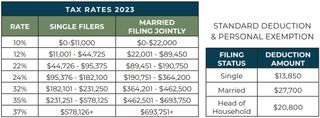Don’t Let the 'Widow's Penalty' Blindside You: How to Prepare
If one spouse passes away, the surviving spouse could pay nearly double the amount of income taxes. Are you planning for this?


The “widow’s penalty” occurs when a person’s tax filing status goes from married filing jointly to single. This change can cause the surviving spouse to have to pay nearly double the taxes compared to what they were paying.
I am going to share an example of a client of ours (we’ll call her Jill) whose spouse (we’ll change his name to Bill) passed away prematurely before Jill started working with us. Their situation is illustrated in the graphic below. Let me walk you through the impact of the widow’s penalty and how severe it was for Jill.

As you can see with this chart, while Bill and Jill were together, they filed their taxes jointly, each received Social Security, and both were older than 73, which means they were forced to take required minimum distributions (RMDs) from the money they had saved in IRAs over all their working years. All their income combined resulted in a tax bill of $11,053. To me, that is a lot of money to have to pay the government, considering Jill and Bill are no longer working. Unfortunately, it gets worse.

Sign up for Kiplinger’s Free E-Newsletters
Profit and prosper with the best of expert advice on investing, taxes, retirement, personal finance and more - straight to your e-mail.
Profit and prosper with the best of expert advice - straight to your e-mail.
When Bill passed, Jill was required to continue the same RMD amount because she was the beneficiary and received all the investments. However, there were two major changes that occurred. The first was that Jill’s Social Security fell off. When one spouse passes away, their Social Security income goes away, and the higher of the two remains. It is great that Jill can take the higher of the two but unfortunate that she will have a loss of income from what she was used to.
This is less of concern since it is typically correct that most surviving spouses will not need 100% of what they needed while their spouse was living, so we can manage that loss. The second change was that Jill’s tax status went from married filing jointly to single.
I have already indicated how severe this is and how it can cause the surviving spouse to pay nearly double the amount of taxes. Let’s explore the tax brackets to understand why this is the case.

As you can see from these charts, two things fuel the fire for the widow’s penalty:
- The standard deduction gets cut in half. This means the surviving spouse will be left with less tax-free income.
- The tax brackets are smaller. For example, if you have $85,000 of taxable income and you are married filing jointly, then you are in the 12% tax bracket, but if you are single with $85,000 of taxable income, then you will be in the 22% tax bracket. See how this can be an issue? This is how that near doubling of taxes can occur.
It bothers me that not only will the surviving spouse have less income, but they will also have to pay more taxes, which leaves them with less money during the time when they need it the most.
How do we plan for this? By utilizing the married filing jointly tax brackets while you can. One spouse is likely to pass away first, so be prepared when that happens.
Also, consider that tax rates may be the lowest we’ll see because they are among historical lows, and most experts expect them to increase due to our country's current debt crisis and overspending. Now may be the best time to pay taxes on those tax-deferred vehicles like your IRA and 401(k) while this tax “sale” is here and while you are still in the more generous married filing jointly tax brackets. You could utilize strategies like a Roth conversion to maximize these types of opportunities.
What else you can do
Another consideration is optimizing when you take Social Security to ensure your spouse will be left with the highest benefit when you pass away. Lastly, if you are going to be drawing larger RMDs in the future, now is the time to start reducing that potential liability, to leave your spouse with less taxable income in the future when it matters the most.
To close, it truly bothers me how severe the widow’s penalty is. Jill was penalized $30,000 per year ($24,000 from the loss of income and $6,000 from the increased tax bill). This is something that can be devastating to surviving spouses, especially when one spouse passes away early — and for those who have done a great job saving. In sum, the tax code penalizes those who have saved and those who have had a spouse pass early.
Unfortunately, you can change only what you can control. We cannot control the tax code or laws, but we can control how we plan for it. So, let's get planning now and make sure our loved ones can continue on with the plan they deserve.
Related Content
- Social Security Strategies to Help Widows Replace Lost Income
- Should I Hire an Estate Planning Attorney Now That I Am a Widow?
- Optimize Your Taxes With These Two Common Strategies
- Social Security for Widowed Parents Falls Far Short of Need
- How to Qualify for Social Security Spousal and Survivor Benefits
Get Kiplinger Today newsletter — free
Profit and prosper with the best of Kiplinger's advice on investing, taxes, retirement, personal finance and much more. Delivered daily. Enter your email in the box and click Sign Me Up.

As Founder and CEO of Peak Retirement Planning, Inc., Joe Schmitz Jr. has built a comprehensive retirement planning company focused on helping clients grow and preserve their wealth. Under Joe’s leadership, a team of experienced financial advisers use tax-efficient strategies, investment management, income planning and proactive health care planning to help clients feel confident in their financial future — and the legacy they leave behind. Joe has also written two Amazon bestselling books, I HATE TAXES (request a free copy) and Midwestern Millionaire (request a free copy). You can find Joe on YouTube by clicking here, where he creates educational videos for those in or near retirement with $1M or more saved. If you would like to talk to Joe’s team, you can schedule a call by clicking here.
-
 Stock Market Today: Dow Adds 353 Points Despite Soft Retail Sales
Stock Market Today: Dow Adds 353 Points Despite Soft Retail SalesInvestors and traders shake off another set of shaky economic numbers and send 10 of 11 sectors higher on Monday.
By David Dittman Published
-
 Loneliness a Risk When Retiring Abroad, Says New Study
Loneliness a Risk When Retiring Abroad, Says New StudyMore Americans want to retire abroad, but loneliness can undermine your happiness and health, even in paradise. Here's how to avoid loneliness abroad.
By Christy Bieber Last updated
-
 10 Tax Topics Every Retiree Should Know About
10 Tax Topics Every Retiree Should Know AboutA little knowledge can go a long way toward saving on your tax bill. Print this out and take it to your tax planner so you can have a productive chat.
By Michael Miller Published
-
 Facing a Layoff? Ask Your Employer These Questions Now
Facing a Layoff? Ask Your Employer These Questions NowIf you're being laid off or forced into early retirement, don't make any decisions without proper guidance — and that starts by asking some key questions.
By Ben Maxwell, ChFC®, AAMS® Published
-
 Have $1M+ Saved? Consider a Financial Planning One-Stop Shop
Have $1M+ Saved? Consider a Financial Planning One-Stop ShopA 'one-stop shop' team — including a financial planner, estate planning lawyer, CPA and more — could serve all of your tax, estate and retirement planning needs.
By Joe F. Schmitz Jr., CFP®, ChFC® Published
-
 Five Ways to Safeguard Your Portfolio in Market Downturns
Five Ways to Safeguard Your Portfolio in Market DownturnsThe stock market is nothing if not volatile these days. When it takes a dip, a well-managed, properly diversified portfolio could help you ride out the storm.
By Joel V. Russo, LUTCF Published
-
 This Underused IRA Option Offers Tax Benefits and Income Security
This Underused IRA Option Offers Tax Benefits and Income SecurityLooking to avoid running out of money in retirement? Consider longevity protection provided by a QLAC as a component of your retirement income plan.
By Jerry Golden, Investment Adviser Representative Published
-
 These Four Books Explore How to Leverage Our Outrage Positively
These Four Books Explore How to Leverage Our Outrage PositivelyThe authors offer some powerful tools to help us find solutions to discord rather than remaining silent or blowing up in anger.
By H. Dennis Beaver, Esq. Published
-
 Financial Pitfalls to Avoid in Your 30s, 40s and 50s
Financial Pitfalls to Avoid in Your 30s, 40s and 50sAs you pass through each decade of working life and build wealth for retirement, watch out for the financial traps that can hinder your progress.
By Julia Pham, CFP®, AIF®, CDFA® Published
-
 Five Key Retirement Challenges (and How to Face Them Head On)
Five Key Retirement Challenges (and How to Face Them Head On)Life will inevitably throw challenges at you as you get older. But making a flexible retirement plan — and monitoring it regularly — can help you overcome them.
By Walt West Published